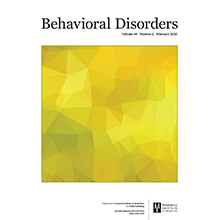본문
Meeting the needs of students with emotional and behavioral disorders during the COVID-19 school closures

By prof. Youn-Jeng Choi,
Department of Education
Research Profile
younjengchoi@ewha.ac.kr
The COVID-19 global pandemic left many educators making an emergency transition to remote instruction when schools were initially closed. While this transition was likely difficult for most students, it may have been particularly difficult for students with emotional or behavioral disorders who have complex and resource-intensive social, emotional, and behavioral needs. The purpose of this study was to examine the extent to which special educators and related service providers felt they were able to meet those needs in the context of the pandemic occurring in the Spring of 2020.
We conducted a survey to understand special education teachers (SETs)’ and related service providers (RSPs, e.g., school psychologists, social workers, counselors, speech-language pathologists (SLPs))’ practices related to supporting the social, emotional, and behavioral needs of students with EBD during the beginning of the COVID-19 pandemic. Though emerging research documents how school personnel (i.e., elementary school teachers and SLPs) reported addressing the needs of students with disabilities during the pandemic, few have examined the role of SETs and RSPs serving students with emotional or behavioral disorders (EBD). In our initial study (Hirsch et al., 2021), we reported the interventions and assessments SETs and RSPs provided to their students with EBD. Given the need to better understand the experiences of these educators and to prepare for future school closures, we conducted a follow-up analysis, which was suggested by reviewers of the initial study. We investigated how policy, technology, and contextual factors influenced the extent to which SETs and RSPs felt they were able to support the social, emotional, and behavioral needs of students with EBDs and implement their individualized education programs (IEPs) during the Spring 2020 school closures. These findings have important implications for practice, policy, and planning.
Overall, respondents indicated they did not feel like they were able to meet the social, emotional, and behavioral needs of their students with EBD. This finding is similar to previous studies of elementary school teachers (Hebert et al., 2020) and SLPs (Sylvan et al., 2020) in the context of COVID-19 related school-closures. We are not surprised by these results given the rapid transition to remote instruction with very little time to develop support systems that could function remotely. SETs and RSPs did not report a strong ability to implement the IEP, but responses were predicted by remote instruction policy. Like meeting emotional and behavioral needs, respondents in schools or districts with mandatory remote instruction fared better. Logically, we presume this is because of the legal requirements associated with IEPs when schools remain “open” and attendance is required, even remotely. Interestingly, educators serving students in non-public schools, that is private, charter, or choice schools, indicated a higher degree of IEP implementation. From a policy perspective, our research suggests that SETs and RSPs generally felt more able to meet students’ needs when instruction was mandated. These findings, coupled with the experience educators have gained as they continue to deliver remote instruction and the known risks and outcomes for our most vulnerable students, we recommend that, when possible, federal, state, and district leaders mandate continuity of instruction during future school closures. However, these policy decisions should be made in consideration of the resources available to different types of schools across a range of settings and locales.
It is important to note that while the current issue of school closures related to the COVID-19 global pandemic are novel, they are closely related to similarly sudden and forced school closures when other crises occur (e.g., weather events, natural disasters, gun violence, and terroristic attacks). Previous research on the effects of Hurricane Katrina on students with EBD indicate potential long-term social, emotional, and behavioral issues stemming from stressors related to that natural disaster. It is logical to consider that the pandemic may have similar effects, particularly in light of this study’s findings that SETs and RSPs did not feel they were effectively able to meet their students with EBDs social, emotional, and behavioral needs. These findings underscore the need for improving current remote instructional practices, but also for future planning to improve the social, emotional, behavioral, and academic outcomes for students with EBD during any long-term school closure.
* References
Hebert, M., Goodrich, J. M., & Namkung, J. M. (2020). Characterizing remote instruction provided by elementary school teachers during school closures due to COVID-19. University of Nebraska-Lincoln. https://doi.org/10.35542/osf.io/vsx4q
Hirsch, S. E., Bruhn, A. L., McDaniel, S., & Mathews, H. M. (2022). A Survey of Educators Serving Students With Emotional and Behavioral Disorders During the Covid-19 Pandemic. Behavioral Disorders, 47(2), 95–107. https://doi.org/10.1177/01987429211016780
Sylvan, L., Goldstein, E., & Crandall, M. (2020). Capturing a moment in yime: A Survey of school-based speech-language pathologists' experiences in the immediate aftermath of the COVID-19 public health emergency. Perspectives of the ASHA Special Interest Groups,5(6), 1735-1749.
* Related Article
Bruhn, Allison, Choi, Youn-Jeng, McDaniel, Sara, Mathews, Hannah Morris, Eisner Hirsch, Shanna, , Meeting the Needs of Students With Emotional and Behavioral Disorders During the COVID-19 School Closures, Behavioral Disorders, Volume 47, Issue 4, January 2022.
